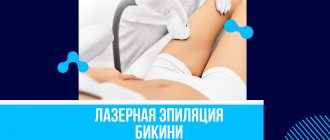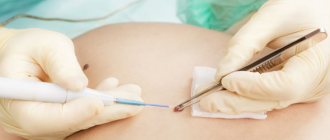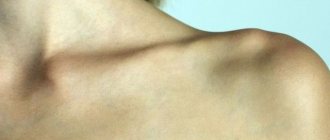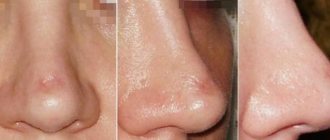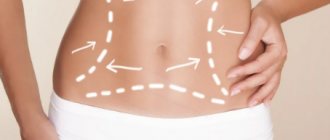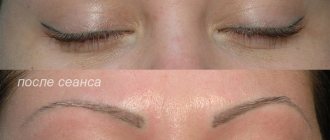Burns after laser hair removal are a possible undesirable effect of hardware hair removal. Injuries are caused by insufficient cooling of the skin or unprofessionalism of the cosmetologist. The procedure involves the destruction of hair follicles with laser beams with a wavelength in the range of 690-800 nm. They are absorbed by the pigment melanin, which is found in hair and skin. Thermal energy destroys the cells of the basal layer of the dermis and the superficial capillaries that nourish the hair follicles. Prolonged contact with laser radiation can cause burns to adjacent tissues.
How does a laser act on the skin: causes of burns
Laser hair removal is the removal of body hair using laser radiation with high energy density. Light exposure to the skin leads to the destruction of follicles and hair root loss. The main causes of thermal burns during the procedure include:
- improper training of a cosmetologist;
- visiting a solarium before the procedure;
- hypersensitivity of the skin;
- laser epilator malfunction.
In 90% of cases, people with dark skin get burns. Due to the increased concentration of melanin, tissues absorb more thermal energy, which provokes thermal injuries.
Contraindications for hair removal
Laser hair removal is accompanied by exposure of the skin surface to light rays. The principle of operation of the device is as follows: a stream of light reaches the bulb and blood vessels, promoting their heating and subsequent death. Therefore, the follicles are destroyed and hair growth stops in the treated area.
A repeated laser hair removal procedure, which is carried out after 25-30 days, removes the remaining hairs that were previously in a state of sleep. After 10 sessions of such manipulation, the follicles become completely incapacitated.
All light devices are accompanied by instructions for use, which detail diseases that are a contraindication to the procedure.
Laser hair removal is prohibited in the following cases:
- Neoplasms of any origin.
- Low immunity associated with severe pathologies.
- Allergies are in the acute stage.
- Any skin diseases, especially infectious ones.
- Diabetes mellitus.
- Varicose veins and spider veins.
It is also worth holding off on this procedure if the client has at least one of the following conditions:
- The period of bearing a child and breastfeeding.
- Hormonal imbalance.
- Infection with viruses and various infections.
- Inflammatory processes on the skin in the area of intended hair removal.
- Flu, cold.
- Damage to the skin - wounds, cuts, scratches.
Selecting the type of laser for your skin type
The choice of laser radiation source depends on the type of skin. To destroy follicles during hair removal, lasers with different wavelengths of light are used:
- neodymium - solid-state emitter with a wavelength of 1060 nm, suitable for people with dark or tanned skin;
- diode – laser emitter with a wavelength of 800 nm, which is suitable for all types of skin;
- alexandrite - a fast-penetrating laser with a wavelength of 700 nm, intended for people with red hair;
- ruby – a laser radiation generator with a working wavelength of 695 nm, which is used to remove light hair from dark skin.
The procedure time depends on the density of the laser beam and the degree of hair growth of the skin.
Depilation should take place in a salon, under the strict guidance of experienced professionals.
The correct choice of light generator prevents unnecessary heating of tissues and damage to the skin.
Efficiency of the procedures performed
The effectiveness of laser procedures has been proven for more than 30 years. And everything is connected with the fact that the laser based on alexandrite uses the optimal wavelength, which interacts most favorably with the hairs. Despite many fakes, the leader in the production of alexandrite lasers is Candela (USA). When using such devices, you can reduce by several times the number of procedures that are necessary to completely get rid of vegetation.
When performing hair removal, you should understand that not all hairs will be removed, but only some of them - this is due to the fact that the laser’s effect will be directed only to hair that is in the active growth phase (anagen).
After one procedure, up to 40% of hairs can be removed.
To achieve the effect of smooth skin, you will need to undergo a full course of procedures. Between each procedure, it is required to maintain a certain time interval, which is up to one and a half months. It all depends on the individual characteristics of the body, as well as on the place of treatment. In some cases, up to eight to ten procedures may be needed.
Signs of a burn after laser hair removal
Burns after laser hair removal look different. The symptomatic picture depends on:
- intensity of light radiation;
- degree of tissue sensitivity;
- duration of laser radiation.
Most often, injuries occur when treating the skin in the bikini area and under the arms. In these areas, the protective layer of the epidermis is thin, making it vulnerable to heat damage. A burn from laser hair removal is indicated by:
- redness;
- swelling;
- itching;
- burning;
- peeling;
- blisters;
- crusts in the lesion.
In 80% of cases, after hardware hair removal, shallow burns of 1st and 2nd degrees are obtained. First, the tissues swell and acquire a reddish tint. When the keratinized epithelium and basal layer of the dermis are damaged, bubbles with transparent contents form. Since the sensory receptors remain unaffected, patients complain of burning or pain.
Improper first aid increases the risk of infectious inflammation. When pyogenic bacteria penetrate the wound, the condition of the tissue worsens. Ulcers form, from which a light green or yellow exudate with a putrefactive odor is released. Infectious inflammation prevents scarring of the skin and provokes complications in the form of trophic ulcers and fistulas.
What types of burns are there?
1st degree - only the upper layer of skin is damaged, redness, dryness, slight swelling, and pain are observed for several days.
1st degree burns do not require medical attention. The area of the body must be placed in cool water; cold compresses can be used. It is possible to take general-spectrum painkillers.
2nd degree - two layers of skin are damaged - the upper layer of the epidermis and the dermis. Blisters form and the pain is very severe. If there are signs of infectious processes and other complications, medical help is required. A complex course can occur in older people, children, and people suffering from chronic diseases.
With 3rd and 4th degree burns, internal tissues, muscles, and organs are damaged, the normal functioning of some body systems is disrupted, severe pain and dehydration appear. Due to the fact that many tissues die, after a while intoxication of the whole body begins.
These burns require immediate medical attention. Before the doctors arrive, the flames on the body are extinguished with a thick blanket. All clothing is removed, except for stuck areas. The victim should be given something to drink to block the process of dehydration.
First aid
A burn after laser hair removal requires immediate treatment of the damaged tissue. First aid involves the following measures:
- Cooling. To stop the heat exposure and prevent further destruction of soft tissue, you need to place the affected area under running water for 10-15 minutes. Alternatives include an ice bag, cold compress, and hypothermic pack. But you should not use them for more than 10 minutes to avoid frostbite.
- Anesthesia. In case of severe pain, the victim is given non-narcotic analgesics - Piroxicam, Ketoprofen, Amidopyrine. To enhance their effect, take 1-2 Spazmalgon tablets.
- Treatment with anti-burn agents. The area of redness is lubricated with ointments with anti-inflammatory and antiseptic effects - Rescuer, Furacilin, Sintomycin. If the epidermis is hypersensitive to drugs, the skin is treated with Panthenol or Dexpanthenol spray. The foam is evenly applied to the affected area, covering 2 cm of healthy tissue around the burn.
- Applying a bandage. Blistering rashes on the burned area are covered with a sterile bandage. The skin is pre-treated with antiseptic ointments - Betadine, Dioxidin, Miramistin, etc. They prevent the penetration of infection and the transformation of the transparent exudate of the vesicles into pus.
If you are burned by laser radiation, you should not treat the affected areas with folk remedies - egg whites with flour, alcohol tinctures, badger fat, vegetable oils, etc. Self-medication is fraught with an increase in the area of the burn and infectious complications. For superficial burns, further treatment is continued at home.
Treatment and skin care after a burn
For relatively shallow burns, only local therapy with antiseptic, analgesic, and wound-healing drugs is carried out. The duration of treatment varies from 3 to 14 days.
If the skin is damaged along with a mole after hair removal, you should consult a doctor to rule out malignancy.
At the initial stage, the following ointments and gels are used:
- Amprovisol is an analgesic and anti-inflammatory drug that has a cooling effect. Prescribed for thermal burns of 1st and 2nd degree. The aerosol is sprayed onto cleansed skin 1-3 times a day.
- Argakol is a gel with glycerol and dioxidine, which has a disinfecting, analgesic and wound-healing effect. Prevents the formation of blisters, protects burn wounds from infections. Apply a thin layer to laser burns 2-3 times a day.
- Dettol Benzalkonium Chloride is a disinfectant solution with anti-inflammatory properties. Intended for the treatment of laser burns complicated by purulent inflammation. The wound is washed 2-4 times a day for a week.
Treatment of laser burns at home is carried out with wound healing ointments. They are used after opening the vesicles to quickly restore the integrity of the epidermis. The most effective pharmaceutical products include:
- Lioxazine is a napkin made of non-woven material with hydrogel impregnation. It has a bactericidal and regenerating effect on burned tissues. Apply to damaged tissues for 30 minutes up to 3 times a day.
- Dexpanthenol is a wound-healing ointment with provitamin B5, which accelerates metabolism in the skin. Accelerates the healing of burns, stimulates local immunity.
- Aekol is a vitamin solution that exhibits antioxidant, wound healing and anti-inflammatory effects. Heals thermal burns and trophic ulcers after laser exposure.
- Algofin is an antimicrobial ointment with a wound-healing effect. Used in combination therapy of burns caused by laser and radiation.
To treat bacterial inflammation of the skin and prevent purulent complications, drugs with antimicrobial action are prescribed:
- Altargo is an antibacterial ointment that prevents purulent inflammation of burns. Apply to damaged areas twice a day for 5 days.
- Dioxidin is a broad-spectrum antibiotic intended for the prevention and treatment of purulent complications. The ointment is used to treat burns once a day for 2 weeks.
- Silvederm is an antimicrobial ointment that accelerates the healing of 1st and 2nd degree burn wounds. Apply to cleansed skin under a bandage 2 times a day.
There are many sebaceous and sweat glands concentrated in the armpits and groin area. Therefore, burns in these areas are often accompanied by infectious inflammation. For abscesses and abscesses, patients are prescribed systemic antibacterial therapy with drugs from the group of cephalosporins, fluoroquinolones - Ceftriaxone, Cefazolin, Pefloxacin.
Definitely!
Is it possible to name the exact number of sessions required for hair removal?
Natalya Grigorieva, Epilike clinic.
Natalya Grigorieva: No. The exact number of procedures depends on the type of laser radiation, power, size of the light spot and the cooling system of the particular laser (how much the heating of the follicle can be increased without pain and risk of burns for the patient). The LightSheer Duet diode laser removes dark hair in 4-6 sessions, light hair in 5-8.
Elena Nasatskaya: No. The Candela GentleLase alexandrite laser treats dark hair in 10 to 12 treatments. It does not remove light ones, but it slows down their growth.
Karina Musaeva: No. Light methods and elos hair removal remove dark hair in 6-8 sessions, light hair in 6-10. More sessions may also be necessary for hormonally controlled areas: chin, upper lip, bikini and underarms. The laser removes hair that is in the active growth phase. On the legs, for example, about 20% is in the anagen stage at the same time (that is, to cover all 100%, at least five procedures will be needed). The hair growth cycle depends on various factors: gender, nationality, hormonal status.
Is it true that you can remove hair forever?
Elena Nasatskaya, Telo's Beauty clinic.
Elena Nasatskaya: No. The hair will disappear within five years, we cannot predict beyond that. Stress, childbirth and taking hormonal medications can shorten this period.
Natalya Grigorieva: No. Only those hairs whose follicles have been completely destroyed are permanently removed. Damaged follicles are restored after one to two years and begin to produce hair of the same “quality.” Single hairs may appear after a course of hair removal; this is normal. It is believed that hormonal imbalance can negate the entire course, but there is no research on this topic. Judging by my practice, this is a myth that wax depilation specialists use to scare their clients.
Karina Musaeva: No. 5-20% of hair can be restored, but it grows thin and weak. To ensure stable results, it is worth doing maintenance procedures 1-2 times a year.
Should hair fall out during or immediately after the procedure?
Natalya Grigorieva: Yes, if we talk about the alexandrite laser and photoepilation. Photoepilation and alexandrite laser use the shaft and tip of the hair 1-2 mm above the surface of the skin as a heat conductor. This gives the effect of “total” loss here and now, but does not mean destruction of the hair follicles. No - if about a diode laser. The diode laser penetrates deeper and does not burn the hair shaft. Before the procedure, they are shaved off, then they grow back and are gradually “pushed out.” Bald spots form in such areas.
Karina Musaeva, Lazerjazz clinic.
Karina Musaeva: During hair removal using an alexandrite laser, neodymium or multiplex, the hair burns during the procedure. To carry out a procedure with elos or diode laser, the skin must be smoothly shaved - that is, after a procedure with any type of laser, the patient leaves with smooth skin. “Dead” rods fall out within 10-20 days.
Elena Nasatskaya: It also depends on the zone. During hair removal using an alexandrite laser, existing hair falls out. Within 2-4 weeks, terminal hair on the legs, arms, armpits and bikini area grows, finally falls out and does not appear again. Hair above the upper lip does not grow back after the procedure.
Is it possible to epilate an area with a tattoo?
Natalya Grigorieva: No. But small tattoos can be painted over with a special white pencil and then this area will not be bypassed.
Karina Musaeva: No. For the laser, the tattoo looks like Fitzpatrick type 4-6 skin. Two chromophores (hair melanin and exogenous tattoo pigment) compete for light absorption. This can lead to burns, keloid and hypertrophic scars.
Is the presence of closely located veins a contraindication?
Natalya Grigorieva: No. The light does not reach the depth of the veins and does not have any negative effect on them.
Elena Nasatskaya: No. The only contraindications are: phlebitis (inflammation of the veins), thrombophlebitis and forms of varicose veins that require treatment.
Karina Musaeva: No. A positive side effect of laser hair removal is the removal of capillaries. Light energy is absorbed by hemoglobin in blood cells and the walls of blood vessels, which leads to their heating and destruction. The vessel disappears.
Is laser hair removal more effective than photo hair removal?
Natalya Grigorieva: Yes. It has been scientifically proven that laser hair removal is a method of permanent hair removal. But there is not a single work that would confirm the same regarding photoepilation. In most countries, it is not used for hair removal - only for the correction of pigment and vascular disorders.
Karina Musaeva: Yes. A laser is a targeted beam of light, photoepilation is a scattered one. It damages, but does not “kill” the follicles permanently. The photoepilation procedure is more painful and lengthy.
Is it possible to do laser hair removal while pregnant?
Natalya Grigorieva: Not worth it. There have been no studies of light radiation on the body of pregnant women. For those who are just planning a pregnancy, laser hair removal sessions can be performed.
Elena Nasatskaya: The manufacturer of the alexandrite laser, Candela, officially allows hair removal starting from the 12th week of pregnancy in remote areas (not the bikini and belly). But I recommend stopping the procedures.
Karina Musaeva: The laser cannot negatively affect the development of the embryo. But in pregnant women, hormonal levels and sensitivity change dramatically - skin pigmentation may be disrupted and procedures will be less effective.
What not to do after the procedure
After hair removal, you need to follow the rules for caring for damaged skin. Ignoring them often causes injuries and complications.
In most cases, cosmetologists advise women to use special restorative creams after laser hair removal.
To avoid unpleasant consequences, you should:
- avoid getting the skin wet for 24 hours after laser treatment;
- stop using hard washcloths for three days;
- avoid exposure to sunlight on the skin;
- refrain from visiting swimming pools and saunas for 1.5-2 weeks;
- Avoid visiting solariums for 14 days.
When removing hair from the facial area, it is not recommended to use scrubs, resort to chemical peeling, or apply self-tanning cream for 10-14 days. You should also refrain from excessive physical activity. For people with excessive skin pigmentation, sunbathing and body massage are contraindicated for a month. Failure to follow the recommendations can result in irritation and superficial burns.
Typically, a laser hair removal course consists of 3-8 sessions. During this period, you need to use regenerating ointments, moisturizing and cooling creams. They restore the hydrolipid mantle of the epidermis. Thanks to this, the skin becomes less sensitive to the effects of laser radiation.
Generations of alexandrite lasers
Currently, there are several generations of alexandrite devices; today, in professional clinics, as a rule, they use a third generation device with an interactive cooling system (usually cryogen).
Before an outbreak occurs, cryogen is sprayed onto the skin, due to which the skin is cooled and possible unpleasant sensations are dulled. Therefore, the appearance of burns on the skin is excluded.
The first generation of lasers had no cooling system at all. It was since then that rumors began to circulate that burns occur after laser hair removal.
The second generation of alexandrite devices had airflow, which reduced the number of unpleasant consequences of the procedure, but cosmetologists were afraid to set the optimal parameters for hair removal, underestimating the power of the device.
After the introduction of cooling systems with special gases and mixtures, the results of hair removal with alexandrite devices are closer to ideal.
If the patient has a high pain threshold, then with the cooling system he will feel light clicks, comparable to the click of a rubber band . All of them are quite tolerable.
Counterfeits of alexandrite lasers
There are several recognized, effective and time-tested manufacturers on the market, the largest of which are Lumenis and Candela. The former produce diode lasers, the latter are leaders in the production of alexandrite lasers.
The cost of one high-quality laser device starts from 4 million rubles!
Unfortunately, the purchase of such equipment is beyond the means of many beauty salons and private hairdressers, which leads to the fact that the latter “denigrate” laser hair removal in every possible way and continue to work with electrodes and wax, while the former try to minimize costs and purchase cheap “analogs.”
The Chinese and Koreans have learned to counterfeit well-known brands very efficiently; often patients do not even see the external difference between a “candela analogue” for 1 million rubles and an original for 5 million.
Offers for the purchase of “gray” and “black” hair removal devices.
When choosing a clinic that offers alexandrite hair removal, be sure to inquire about the year of manufacture of the device and its manufacturer.
Possible complications
Laser hair removal devices rarely cause negative consequences. But when depilating the bikini, armpits, groin and other areas with sensitive skin, the following sometimes occur:
- redness;
- perifollicular edema;
- hyperpigmentation;
- photosensitivity;
- folliculitis;
- exacerbation of herpes.
The severity of side effects depends on the density of the laser beam, hair and skin color. Complications are more common in dark-skinned people, since darker skin absorbs more thermal energy. Because of this, not only the hair follicles are destroyed, but also the surrounding tissues.
Who is contraindicated for laser hair removal?
Laser hair removal on the body has absolute and relative contraindications. The first category includes:
- decompensated diabetes mellitus;
- squamous cell skin cancer;
- blonde hair;
- low blood clotting;
- leukemia;
- individual intolerance to the procedure.
The procedure is not performed on persons under 18 years of age. Relative contraindications include:
- exacerbation of herpes;
- hypopigmentation;
- fresh tan;
- relapses of allergic dermatosis;
- burns, acne, pimples in the treated area;
- pregnancy;
- multiple moles on the body;
- phlebeurysm.
Ignoring contraindications is fraught with burns, keloid scars, and malignancy of tumors. In patients with excessive sweating and sebum secretion, the risk of inflammation of the hair follicles increases. Folliculitis in people with immunodeficiency is dangerous due to furunculosis.
If you have dark skin, you should not use alexandrite lasers, as they are highly likely to cause deep burns. You should also refrain from hair removal during exacerbation of ENT diseases - laryngitis, bronchitis, sinusitis, etc.
Reviews
I was resurfacing a scar on my arm that was left after an accident when I had surgery. For two years I thought that it would resolve itself, but it didn’t happen. It brightened, but did not become smaller. The view was so-so. The surgeon removed it with a laser in one go. It wasn’t even worth waiting that long, but should have done it right away.
Alexander (Aprelevka, December 2013)
I had a scar on my cheek resurfaced after an injury at the clinic. In summer, the scar looked very unaesthetic and was very different in color from tanned skin. Three sandings were enough to leave almost no mark. Now I'm waiting for summer to see how different the area under the scar will be on tanned skin. The surgeon said that it would be practically invisible. The impression is great!
Sergey (Moscow Region, Naro-Fominsk, 2014)
I went to the clinic to resurface a scar on my arm after a car accident. The scar is about 5 cm on the inner surface of the arm. I couldn't wear short sleeves in the summer as it looked terrible. For a long time I didn’t dare to start removing it, but a friend advised me to do laser resurfacing. Now after three procedures the scar is practically invisible. She refused anesthesia for the operation herself. It was unpleasant, but not terrible. But then everything passed quickly. After three weeks the wound healed. I recommend the surgeon Mitish E.V.
Valentina (Moscow, 2013)
“Ten years ago, a terrible event happened: glass from a broken window left noticeable scars on my face. It was very scary to decide to have an operation - what if it gets even worse? So I suffered for so many years... Maybe I still would, if my friend had not literally led me by the hand to “Lama” to Nikeshin Akim Yosifovich. He is not just a wonderful person, but a great specialist, as is everyone else in this clinic. This is how I received a “new face” and help that I had never even dreamed of. Thanks everyone."
Alena (Balashikha, 2015)
In the office kitchen, I poured hot soup on my foot when I took it out of the microwave. The burn was 10 square centimeters. It didn’t heal for a long time, and then a scar remained on my leg. So she had it removed at the clinic. I had laser resurfacing of the scar under local anesthesia. It didn't hurt. The leg became straight, without bumps. It is still visible that the skin is a different color, but I hope that by summer everything will pass. I liked the clinic. The attitude of the staff and doctors is very good. There is a positive atmosphere in the clinic.
Kristina (Moscow, April 2014)
I would like to express my gratitude to Dr. Evgeniy Nikolaevich Burkun! I contacted him about laser resurfacing of a scar on my leg. The doctor told me everything about the procedure and warned that in my case it would take several sessions for the scar to be completely invisible. In total, I had to do the polishing in three sessions, but each time it was short-lived and without any unpleasant sensations. Now I am completely satisfied with the result, there is normal smooth skin at the site of the large scar.
Svetlana (Moscow 2017)
Last year I burned my hand. She was very careful with the burn while the wound healed, but a scar still remained. I went to the clinic for laser scar resurfacing. I had three operations between each of which there was a month. By the third time the scar was no longer visible at all. I was very afraid that it wouldn’t work out, but everything turned out great. Thank you very much to surgeon Mitish. E.V. I'm very glad that everything worked out.
Alexandra (Moscow, 2014)
About 10 years ago I burned my hand while repairing a car on a manifold, and then picked off the sore. So the scar on my hand remained for all these years, until I decided to finally remove it. I had a burn scar resurfaced with a laser at the Lama clinic with surgeon Elena Valerievna. I was very pleased with both the result and the clinic. The atmosphere is cozy, there are no queues, everything is by appointment. Convenient and inexpensive.
Leonid (Moscow, August 2013)
I had an old burn on my leg the size of a 5 ruble coin. I decided to remove it before the summer season. I spent a long time choosing a method and decided to do laser resurfacing at the Lama clinic. Honestly, I'm very pleased. The clinic is very good, everything is clean. Friendly staff. The price list was exactly what it was. After two procedures, there was practically no trace left of the scar. It was done under local anesthesia. It didn’t hurt at all, and then it didn’t hurt very much. I recommend everyone not to hesitate, but to do laser surgery.
Victoria (Moscow, 2013)
“After a difficult case of peritonitis, from which all the hospital doctors saved me, I was left with three huge scars all over my stomach, which I really wanted to get rid of. I searched for a clinic for a long time and accidentally found out about Lama. After conducting a consultation, Evgeniy Nikolaevich Burkun promised to help me and fulfilled his promise. A year after surgery, I can wear a swimsuit without embarrassment because my scars are practically invisible. I also want to thank the clinic staff, who take great care of the patients, and recommend Lama.
Alexandra (Moscow, 2015)
A year ago I had surgery, which left a scar on my stomach. It was especially noticeable in the summer, when the rest of the skin was tanned. Before the summer season I had laser resurfacing of the scar. I am very pleased with the result. All marks were completely gone within a month after sanding. I hope that the skin will now tan evenly too. I recommend doing such procedures not in beauty salons, but in clinics. There are professionals on a completely different level, not just cosmetologists. I am very pleased with the llama.
Olga (Moscow, March 2014)
Articles on the topic
Face resurfacing for scars
Beautiful, clean and healthy skin is the dream of not only women, but also representatives of the stronger half of humanity. But what should those whose skin has imperfections, such as scars, scars or acne spots, do? Modern cosmetology offers many options […]
Prevention of skin trauma
To avoid burns, you need to follow the rules for preparing the skin for the laser procedure:
- 3-4 days before hair removal, do not use alcohol-containing solutions or ointments;
- do not visit solariums or tan in the sun for 14 days;
- do not remove hair by other means within 20 days;
- do not take tetracycline antibiotics 2 weeks before the procedure.
To achieve the desired effect, it is recommended to shave the epilation area 8 hours before the session. After each procedure, you need to use cooling gels that prevent overheating of the skin and superficial burns. Compliance with the recommendations prevents side effects and complications.


